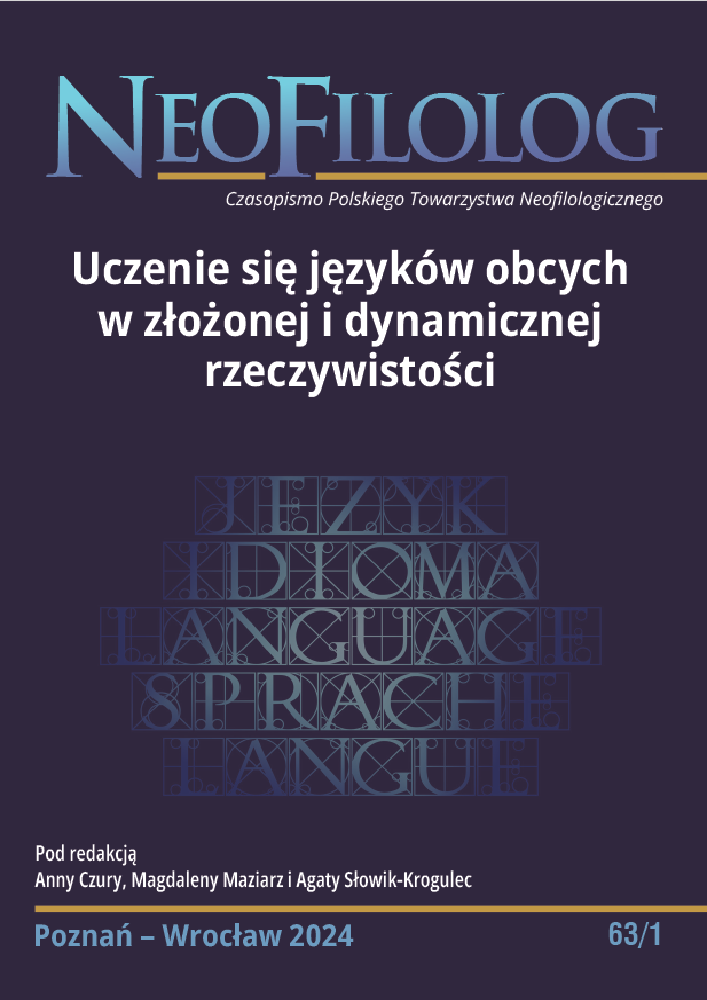Abstract
Lexical competence of teenage heritage and native users of Polish has never been the subject of a comprehensive comparison. The first extensive empirical data were gathered by the Jagiellonian University research team in the project Heritage and native language – a comparison of language competences of teenage Polish and heritage learners. In the first stage of the present study, vocabulary tests of the two groups were analyzed. The results showed few differences in receptive knowledge, but in productive knowledge heritage users lagged behind. Therefore, in the second stage, selected essays were compared in terms of their vocabulary profiles. It was found that native and heritage language users’ lexical profiles differ markedly, to the considerable disadvantage of heritage users. Polish educators responsible for the schooling of migrant children must be aware of this, as too often heritage speakers who enter home schools after (re)immigration are treated as if there were native users. This however, as this research has clearly shown, is by no means the case.
References
Aitchison J. (1994), Words in the Mind. Oxford: Blackwell.
Cummins J. (2000), BICS and CALP, (w:) M. Byram (red.), Routledge Encyclopedia of Language Teaching and Learning. New York: Routledge, s. 76–79.
ESOKJ (2003): Europejski system opisu kształcenia językowego: uczenie się, nauczanie, ocenianie. Warszawa: Wydawnictwo CODN.
Fishman J.A. (2001), 300-Plus Years of Heritage Language Education in the United States, (w:) Kreeft Peyton J., Ranard D.A., McGinnis S. (red.), Heritage Languages in America. Preserving a National Resource. Washington, DC & McHenry, IL: Center for Applied Linguistics & Delta Systems, s. 81–99.
Janowska I. i in. (2011), Programy nauczania języka polskiego jako obcego. Poziomy A1 – C2. Kraków: Księgarnia Akademicka.
Kielar-Turska M. (1989), Mowa dziecka. Słowo i tekst. Kraków: Wydawnictwo Uniwersytetu Jagiellońskiego.
Laufer B (1991), The development of L2 lexis in the expression of the advanced language learner. „Modern Language Journal”, nr 75, s. 440–448. DOI: https://doi.org/10.1111/j.1540-4781.1991.tb05380.x
Laufer B., Nation I.S.P (1995), Vocabulary size and use: lexical richness in L2 written Production. „Applied Linguistics”, nr 16(3), s. 307–322. DOI: https://doi.org/10.1093/applin/16.3.307
Lipińska E. (2003), Język ojczysty, język obcy, język drugi. Wstęp do badań dwujęzyczności. Kraków: Wydawnictwo Uniwersytetu Jagiellońskiego.
Lipińska E., Seretny A. (2012), Między językiem ojczystym a obcym. Nauczanie i uczenie się języka odziedziczonego w chicagowskiej diasporze polonijnej. Kraków: Księgarnia Akademicka.
Lipińska E., Seretny A. (2016), Język odziedziczony – polszczyzna pokoleń polonijnych. „Poradnik Językowy”, nr 10, s. 45–61.
Lipińska E., Seretny A. (2022), Nauczanie języka przez literaturę, a literatury przez język – o metodzie skorelowanej w pracy z uczniami polonijnymi. „Filologia Polska. Roczniki Uniwersytetu Zielonogórskiego”, nr 8, s. 19–36. DOI: https://doi.org/10.34768/fp2022a1
Martyniuk W. (2015), Edukacyjna sprawność językowa w ujęciu działaniowym Rady Europy. „LingVaria”, nr 2, s. 69–79. DOI: https://doi.org/10.12797/LV.10.2015.20.06
Montrul S. (2016), The Acquisition of Heritage Language. Cambridge: Cambridge University Press.
Pamuła-Behrens M. (2018), Język edukacji szkolnej w integracyjnym modelu wsparcia ucznia z doświadczeniem migracji w rodzinie. „Postscriptum Polonistyczne”, nr 2(22), s.171–186. DOI: https://doi.org/10.31261/PS_P.2018.22.11
Richards J. (1976), The Role of Vocabulary Teaching. „TESOL Quarterly”, nr 1, s. 77–90. DOI: https://doi.org/10.2307/3585941
Schleppegrell M.J. (2004), The Language of Schooling: A Functional Linguistics Perspective. Mahwah, NJ: Erlbaum. DOI: https://doi.org/10.4324/9781410610317
Seretny A. (2011), Kompetencja leksykalna uczących się języka polskiego jako ankietowa w świetle badań ilościowych. Kraków: Universitas.
Seretny A. (2021), Polszczyzna w szkole, czyli język jako narzędzie poznania, (w:) Seretny A., Lipińska E. (red.), Dydaktyka języka polskiego jako nierodzimego. Konteksty – dylematy – trendy. Kraków: Universitas, s. 113–140.
Seretny A. (2022), Polszczyzna jako język drugi w szkole. Wymagania leksykalne komunikacyjnej i edukacyjnej odmiany języka, „Neofilolog”, nr 58(1), s. 98–118. DOI: https://doi.org/10.14746/n.2022.58.1.7
Seretny A., Lipińska E. (2023), Kompetencje uczniów w zakresie języka polskiego jako odziedziczonego i jako ojczystego w ujęciu komparatywnym – podsumowanie projektu badawczego. „Acta Universistais Lodziensis. Kształcenie Polonistyczne Cudzoziemców”, nr 30, s. 293–303. DOI: https://doi.org/10.18778/0860-6587.30.18
Synowiec H. (1995), Rozwój słownictwa nazywającego cechy osobowości w języku dzieci i młodzieży. Katowice: Wydawnictwo Uniwersytetu Śląskiego.
Snow C. (1993), Literacy and language: Relationships during the preschool years. „Harvard Educational Review”, nr 53, s. 165–189. DOI: https://doi.org/10.17763/haer.53.2.t6177w39817w2861
Zarębina M. (1965), Kształtowanie się systemu językowego dziecka. Wrocław: Zakład Narodowy im. Ossolińskich.
License
Copyright (c) 2024 Anna Seretny

This work is licensed under a Creative Commons Attribution-NoDerivatives 4.0 International License.
Authors
Authors of texts accepted for publication in Neofilolog are required to complete, sign and return to the Editorial team’s office the Agreement for granting a royalty-free license to works with a commitment to grant a CC sub-license.
Under the agreement, the authors of the texts published in Neofilolog grant Adam Mickiewicz University in Poznań a non-exclusive, royalty-free license and authorize the use of Attribution-NoDerivatives 4.0 International (CC BY-ND 4.0) Creative Commons sub-license.
The authors retain the right to the free disposal of the work.
Users
Interested Internet users are entitled to use works that have been published in Neofilolog since 2017, under the following conditions:
▪ attribution – obligation to provide, together with the distributed work, information about the authorship, title, source (link to the original work, DOI) and the license itself.
▪ no derivatives – the work must be preserved in its original form. Without the author's consent, it is not possible to distribute the modified work in the form of translations, publications, etc.
Copyrights are reserved for all texts published since 2017.
Miscellaneous
Adam Mickiewicz University in Poznań retains the property right as a whole (layout, graphic form, title, cover design, logo etc.).

